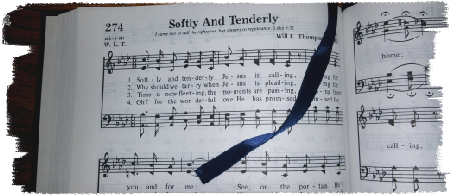
I came across an item of interest recently, stating that very few hymnals used by the religious denominations have a silk marker attached to the book.
Of course, every song book I have come across in the various places where I have worshiped has one. And yet, in the religious world at large it is rare.
Why do we have the silk ribbon? As far as I can tell, solely to mark our books for the invitation song. Consider the progression. Before the ribbon came the book, before the book came the concept of an invitation song, before the invitation song came the offering of an invitation.
There certainly is no requirement for the ribbon. It does, however, make it simple to begin the song immediately at the end of the sermon. It is an expedient method of getting everyone on the “same page” and helps this aspect of our worship to be done “decently and in order” (cf. 1 Corinthians 14:40).
When we talk about “expedients” we are talking about authority. We often emphasize that something can not be considered expedient if it is not in some way authorized in scripture. The nature of an expedient is that it falls within the scope of what we might call general authority. For example, we are given the command to teach (cf. Matthew 28:20). Within the command to teach there is authority for expedients like classbooks and other materials, things that help us to fulfill the command to teach.
Consider the applications of this principle that have led to the use of a silk bookmark. First, we are given the command to sing as a congregation. Paul, in Ephesians 5:19, instructs us to speak “to one another in psalms and hymns and spiritual songs, singing and making melody in your heart to the Lord.” There are certain expedients that we use to accomplish that command to sing, among them the use of written music, bound in a book.
We are also given the command to preach. Paul instructed Timothy, “Preach the word! Be ready in season and out of season. Convince, rebuke, exhort, with all longsuffering and teaching” (2 Timothy 4:2). As a part of his sermon on Pentecost, Peter included an appeal, or invitation, to respond to the message. “Then Peter said to them, ‘Repent, and let every one of you be baptized in the name of Jesus Christ for the remission of sins; and you shall receive the gift of the Holy Spirit’” (Acts 2:38).
The traditional order of worship that is commonly practiced in our congregations is designed to expedite that response to the gospel. It is authorized in that it is a fulfillment of the commands to preach the word, and to instruct one another through song. As the purpose of preaching is to convict hearts, it is appropriate to offer the convicted person an opportunity to act upon his conviction. The singing of a song which encourages and instructs the sinner to repent is an expedient means of encouraging that response.
The books and the marker contribute to this, as they lessen any confusion or delay that might discourage a response to the sermon preached. In this way, our tradition of marking our books with a little silk ribbon, for an invitation song, has served as the setting for responses to the gospel, thus the salvation of souls.
Are there other ways this might be done? Certainly! We have settled on this, and I am convinced it is effective and helpful as we seek to save souls. Most importantly, it is authorized, and thus pleasing to God.
To see The Patternists Page on Facebook, click here, and Like!




